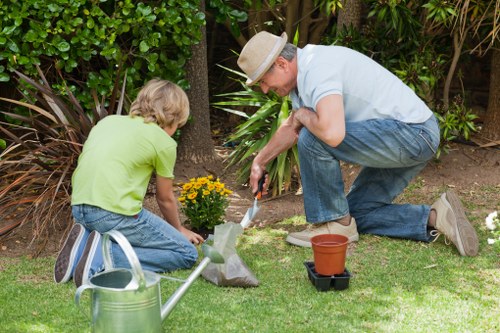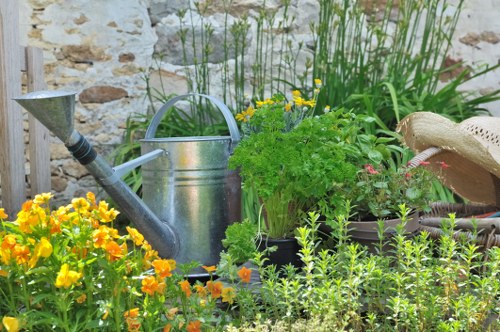Hedge Trimming in Barnes: Achieving a Pristine Landscape
Introduction to Hedge Trimming

Hedge trimming is an essential aspect of maintaining a beautiful and healthy garden. In Barnes, where gardens are treasured for their aesthetic appeal and tranquility, proper hedge maintenance can significantly enhance the overall look of any property. Whether you’re a homeowner seeking to improve your garden’s appearance or a professional landscaper aiming to offer top-notch services, understanding the nuances of hedge trimming is crucial.
Regular trimming not only keeps hedges in shape but also promotes healthy growth by encouraging new shoots and preventing overgrowth. This practice helps in maintaining the desired height and density, ensuring that hedges serve their intended purpose as privacy screens, windbreaks, or ornamental features in the garden.
In Barnes, the climate and soil conditions make certain hedge species thrive, while others may require more attention and specialized care. Selecting the right tools and techniques is vital for achieving the best results, whether you’re dealing with evergreen hedges like boxwood or deciduous varieties like privet.
Benefits of Regular Hedge Trimming

There are numerous benefits to maintaining regularly trimmed hedges. Firstly, neatly trimmed hedges enhance the visual appeal of your garden, giving it a well-kept and orderly appearance. This is particularly important in neighborhoods like Barnes, where curb appeal can significantly impact property values.
Secondly, regular trimming helps in controlling the size and shape of the hedges, preventing them from encroaching on other parts of the garden or neighboring properties. This level of control allows for better garden design and spatial management, ensuring that each element of your landscape has its designated place.
Moreover, hedge trimming contributes to plant health by removing dead or diseased branches, which can prevent the spread of pests and diseases. By keeping hedges free from debris and overgrowth, you create a healthier environment for the plants to thrive, resulting in lush and vibrant greenery.
Choosing the Right Tools for Hedge Trimming

Essential Tools for Effective Trimming
Using the right tools is fundamental to achieving precise and efficient hedge trimming. The most common tools include:
- Pruning Shears: Ideal for small hedges and detailed work, pruning shears allow for precise cuts.
- Hedge Trimmers: Available in manual and electric versions, hedge trimmers are perfect for larger hedges and more extensive trimming tasks.
- Loppers: These are necessary for thicker branches that pruning shears cannot handle.
- Safety Gear: Protective gloves, eyewear, and sturdy footwear are essential to ensure safety during trimming.
Investing in high-quality tools not only makes the trimming process easier but also ensures that the cuts are clean and do not damage the plants. Regular maintenance of these tools, such as sharpening blades and oiling moving parts, can extend their lifespan and performance.
Techniques for Effective Hedge Trimming

Basic Trimming Methods
Effective hedge trimming involves several key techniques to ensure the best results:
- Plan Your Trim: Before starting, decide on the desired shape and size of the hedge. Sketching a rough outline can help guide your trimming process.
- Trim During the Right Season: The optimal time for hedge trimming in Barnes is typically late winter or early spring before new growth begins. However, some hedges may benefit from summer trimming as well.
- Maintain Symmetry: Aim for an even and symmetrical appearance by making balanced cuts on all sides of the hedge.
- Use the Right Angle: Cutting at a slight angle can facilitate better growth and a more natural look.
- Step Back Frequently: Regularly step back to assess the hedge’s shape and make adjustments as needed to maintain consistency.
By following these techniques, you can achieve a professional-looking trim that enhances the beauty and health of your hedges.
Common Hedge Types in Barnes

Popular Species for Local Gardens
Barnes boasts a variety of hedge species, each with its unique characteristics and maintenance requirements. Some of the most common types include:
- Boxwood: Known for its dense foliage and versatility, boxwood is a popular choice for formal hedges and intricate shapes.
- Privet: Privet hedges are favored for their rapid growth and ability to form thick, impenetrable barriers.
- Holly: With its glossy leaves and bright berries, holly hedges add both functionality and ornamental value.
- Beech: Beech hedges are prized for their attractive color and suitability for larger landscapes.
- Laurel: Laurel provides dense foliage and is excellent for privacy screens, though it requires regular maintenance to prevent overgrowth.
Choosing the right hedge type depends on factors such as growth rate, maintenance level, and the specific needs of your garden. Consulting with a local horticulturist can help you make an informed decision tailored to your landscape.
Hiring Professional Hedge Trimmers in Barnes
When to Consider Professional Services
While DIY hedge trimming can be a rewarding task, there are times when hiring professional services is beneficial. Professionals bring expertise, precision, and the right equipment to handle complex trimming jobs efficiently.
Benefits of hiring professionals include:
- Expertise: Professionals understand the specific needs of different hedge species and can tailor their approach accordingly.
- Time-Saving: Large or numerous hedges can be time-consuming to trim. Professionals can complete the job quickly and effectively.
- Safety: Trimming tall or dense hedges can pose safety risks. Professionals have the necessary training and equipment to mitigate these risks.
- Consistent Results: Professionals ensure that hedges are trimmed uniformly, enhancing the overall aesthetic of your garden.
In Barnes, several landscaping companies specialize in hedge trimming, offering various packages to suit different needs and budgets. It’s advisable to seek recommendations and read reviews to choose a reputable service provider.
Maintaining Healthy Hedges
Tips for Long-Term Hedge Health
Maintaining healthy hedges goes beyond regular trimming. Here are some essential tips to ensure your hedges remain vibrant and robust:
- Proper Watering: Ensure hedges receive adequate water, especially during dry spells. However, avoid overwatering, which can lead to root rot and other issues.
- Fertilization: Providing the right nutrients through appropriate fertilizers can promote healthy growth and enhance the color of your hedges.
- Pest and Disease Control: Regular inspections can help identify and address pest infestations or diseases early, preventing significant damage.
- Mulching: Applying mulch around the base of hedges can help retain moisture, suppress weeds, and regulate soil temperature.
- Pruning Dead or Damaged Branches: Removing unhealthy branches prevents the spread of diseases and encourages the growth of strong, healthy shoots.
By following these maintenance practices, your hedges will not only look great but also contribute to the overall health and beauty of your garden.
Seasonal Hedge Trimming in Barnes
Adapting Trimming Practices Throughout the Year
Different seasons require different approaches to hedge trimming to accommodate the changing growth patterns and environmental conditions. Here’s how to adapt your trimming practices throughout the year in Barnes:
- Spring: Early spring is ideal for a major hedge trim before new growth begins. This encourages vigorous development and maintains the desired shape.
- Summer: Light trimming during summer can help manage growth and prevent hedges from becoming too dense. It’s also a good time to remove any flowers or fruit that may hinder further growth.
- Autumn: Late autumn trims focus on shaping and controlling the hedge’s size before the winter months. Removing dead or damaged branches during this time prepares the hedges for the colder season.
- Winter: In winter, hedge trimming should be minimal. Only remove any branches that have been damaged by frost or storms to prevent further issues.
Adjusting your trimming schedule according to seasonal changes ensures that your hedges remain healthy and aesthetically pleasing year-round.
Eco-Friendly Hedge Trimming Practices
Sustainable Approaches to Garden Maintenance
Adopting eco-friendly practices in hedge trimming not only benefits the environment but also promotes the long-term health of your garden. Here are some sustainable approaches to consider:
- Use Manual Tools: Whenever possible, opt for manual hedge trimmers to reduce carbon emissions and noise pollution associated with motorized tools.
- Recycle Green Waste: Instead of disposing of trimmings in the trash, consider composting them or using them as mulch to enrich your garden’s soil.
- Choose Native Plants: Selecting native hedge species can reduce the need for excessive watering and fertilizers, as they are well-adapted to the local climate and soil conditions.
- Limit Chemical Use: Minimize the use of chemical pesticides and fertilizers by opting for organic alternatives to maintain a healthy and balanced ecosystem in your garden.
- Conserve Water: Implement efficient watering systems and practices to ensure your hedges receive the necessary moisture without wasting water resources.
By integrating these eco-friendly practices, you contribute to a sustainable environment while maintaining beautiful and healthy hedges in your Barnes garden.
Common Mistakes to Avoid in Hedge Trimming
Ensuring Successful Trimming Outcomes
Even with the best intentions, certain mistakes can compromise the effectiveness and health of your hedges. Here are common pitfalls to avoid:
- Over-Trimming: Removing too much foliage can stress the plants and hinder their ability to photosynthesize, leading to weakened growth.
- Trimming at the Wrong Time: Cutting hedges during sensitive periods, such as flowering or fruiting seasons, can disrupt their natural cycles and reduce their aesthetic value.
- Ignoring Plant Health: Failing to address diseases or pest issues before trimming can exacerbate the problems, making it harder for the hedge to recover.
- Improper Tool Use: Using dull or inappropriate tools can cause uneven cuts and increase the risk of damaging the plants.
- Lack of Planning: Trimming without a clear plan can result in an unbalanced or asymmetrical appearance, detracting from the garden’s overall look.
By being mindful of these common mistakes, you can ensure that your hedge trimming efforts lead to beautiful and healthyResult hedges.
Enhancing Curb Appeal with Well-Trimmed Hedges
Making a Lasting Impression
Well-trimmed hedges play a crucial role in enhancing the curb appeal of your property. In Barnes, where gardens are an extension of the home’s beauty, neatly maintained hedges can significantly boost your residence’s overall attractiveness.
Some of the ways well-trimmed hedges enhance curb appeal include:
- Framing Your Property: Hedges can outline the boundaries of your garden, creating a polished and defined space.
- Adding Structure: Structured hedges provide a sense of order and sophistication, complementing various architectural styles.
- Creating Depth: Layered hedges can add depth and dimension to your garden, making it appear larger and more dynamic.
- Highlighting Features: Strategically placed hedges can draw attention to specific areas of your garden, such as flower beds or decorative elements.
- Providing Privacy: Tall, dense hedges offer privacy, making your garden a secluded and tranquil retreat.
Investing time and effort into regular hedge trimming not only keeps your garden looking pristine but also elevates the overall value and appeal of your property.
DIY vs. Professional Hedge Trimming
Making the Right Choice for Your Needs
Deciding between DIY hedge trimming and hiring a professional service depends on various factors, including the size of your hedges, your gardening skills, and the time you can allocate to maintenance.
Advantages of DIY Hedge Trimming
- Cost-Effective: Trimming hedges yourself can save on labor costs associated with hiring professionals.
- Personal Satisfaction: Many gardeners find the process of trimming hedges rewarding and fulfilling.
- Flexibility: DIY trimming allows you to work at your own pace and schedule.
Advantages of Professional Hedge Trimming
- Expertise and Precision: Professionals have the skills and experience to achieve immaculate trimming results.
- Time-Saving: Hiring a service frees up your time for other tasks or leisure activities.
- Access to Advanced Tools: Professionals use specialized equipment that may not be readily available for DIY projects.
Ultimately, the choice between DIY and professional hedge trimming should be based on your specific circumstances and preferences. For larger or more complex trimming tasks, seeking professional assistance may yield better and more efficient results.
Conclusion: Maintaining Beautiful Hedges in Barnes
Investing in Your Garden’s Future
Hedge trimming is a vital component of garden maintenance in Barnes, contributing to both the aesthetic appeal and health of your landscape. By understanding the benefits, selecting the right tools, employing effective techniques, and knowing when to seek professional help, you can ensure that your hedges remain lush, well-shaped, and vibrant throughout the year.
Moreover, adopting eco-friendly practices and avoiding common trimming mistakes can further enhance the sustainability and longevity of your garden. Whether you choose to tackle hedge trimming yourself or hire skilled professionals, the effort invested in maintaining your hedges will pay off in the form of a stunning and inviting outdoor space that you can enjoy for years to come.
Contact us today to book your hedge trimming service and transform your Barnes garden into a picturesque retreat.